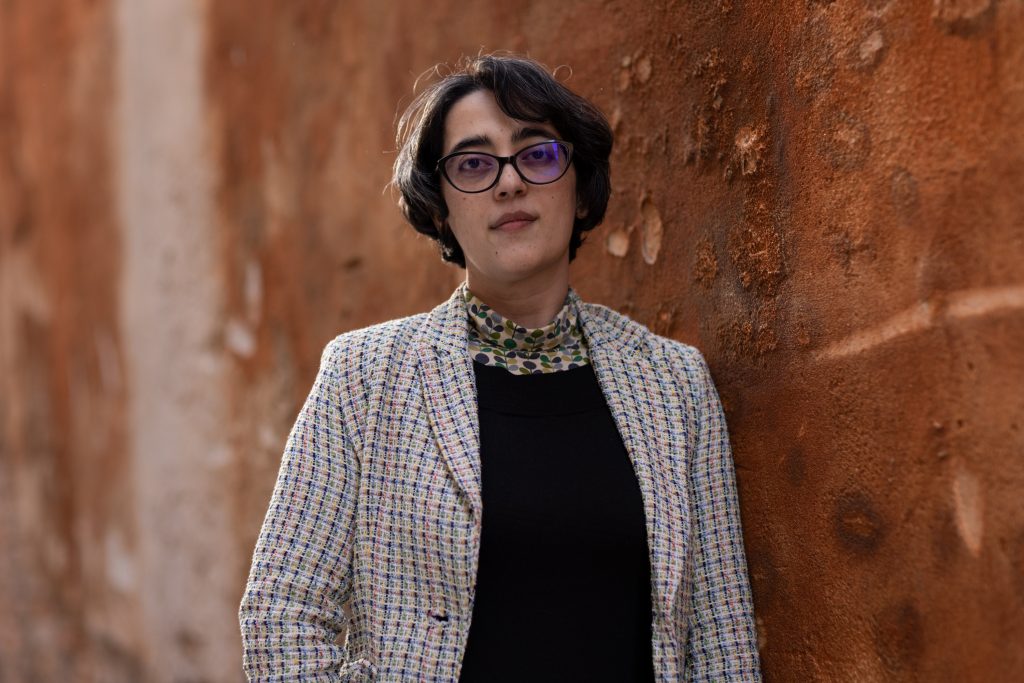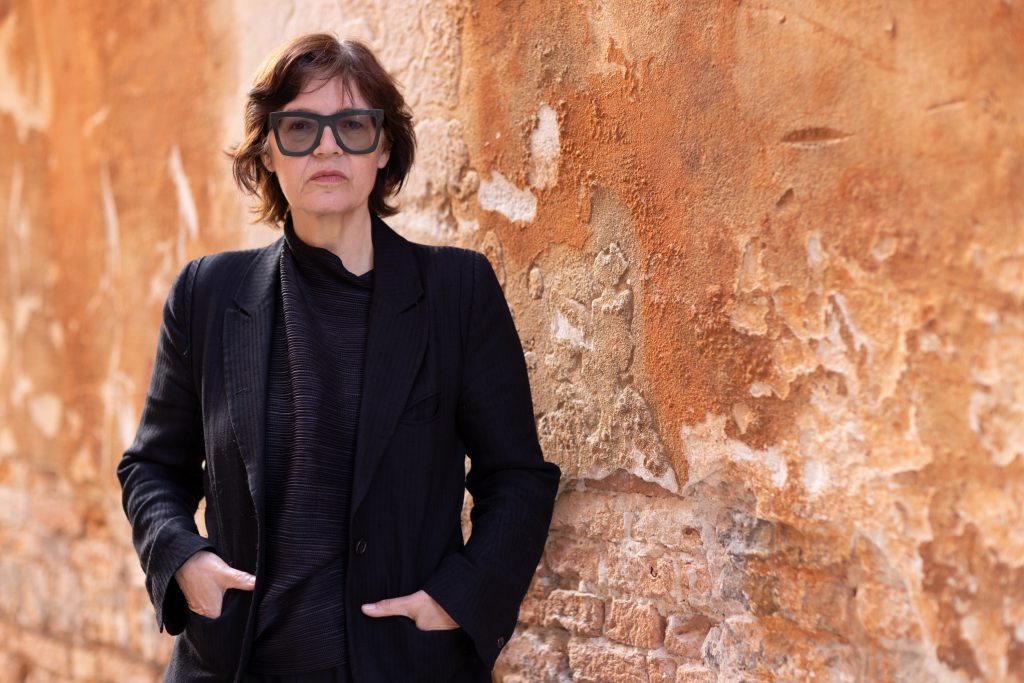
Approaching the Pavilion entrance, one steps between what appears to be sheets of paper holding us within its folds, much like the enveloping that occurs in the act of reading. Entering the hanging paper maze, its layers unfold to reveal not only the architecture of a book, but also Shubigi Rao’s journey of discovery into the world of stories centred on books, for hundreds of chronicles are at the core of this work.
The next encounter is a multivocal filmic experience that explores, by way of personal confidences and poetic reflections, documentary and mytho-poetic languages, the tales of those at the frontlines of saving books and libraries. These people speak of smuggling volumes out of danger, preserving endangered languages and vanishing cultures, while sharing the sorrow of losing access to personal and collective pasts and histories.
Partially filmed in Venice, a city that embodies a vital history of print and open access, the film Talking Leaves depicts, among other stories, how books from a now-defunct archive of women partisans and genocide survivors, are rescued.

Discussions about the historical connections of access to knowledge and political power with Italian professor of book history Mario Infelise are interwoven with conversations with Singaporean researcher Faris Joraimi about the cultural politics and intellectual history of the Malay world.
Venetian librarian Ilenia Maschietto shares stories of banned books and her favourite books of resistance, while Marco Borghi explains how alternative archives can act as safeguards of democracy. The poet Bianca Tarozzi invites us into her library sharing the books that survived the devastating 2019 floods in Venice.
Singaporean writer Melissa de Silva reads aloud from a book of idioms in Kristang, an endangered language of Malacca’s and Singapore’s Eurasian communities. Retired librarian Saralee Turner recites passages from ‘Not Out of Hate’ by Myanmar writer Ma Ma Lay, while another describes the threats to contemporary libraries and free knowledge.

Through these stories, we see the book as the embodiment of collective thought, labour and readership, and we recognise the book as an intimate holder of humanity and community.
Copies of Rao’s new book, Pulp III: An Intimate Inventory of the Banished Book (Pulp Vol. III), are arranged in a way that speaks of the monumentality of its format as a container of knowledge.
Pulp Vol. III chronicles Rao’s long-term artistic research process and conceptual reframing of the book and the library, whilst adding new research on Singapore and Venice as historic centres of print. Over the course of the Biennale Arte 2022, this installation of books will
change in form as they are dispersed into the world. For Rao, each book is a messenger, a time-traveller, the embodiment of our need to communicate, and a rallying call to action.
In reference to the work, Shubigi Rao said: “What are our testimonies, and what is it we affirm? Are our certainties just circles of rationalising, restless half-truths, vivid imaginings and cynical manipulations? Or can we ask where the smallest form can speak to larger testaments? Every mark we read or see was made to bear witness to brief life and briefer designs. Every text then is a testimony, not necessarily of truth, but an illuminating of time, idea, of the facts and falsities of place and moment. In this way, the stories in the Pulp project point to different forms of courage, in action, in speech, in documenting and in sharing. These stories also make visible the nuanced forms of resistance in print, and of lives lived surrounded by books, of breathing air heavy with the weight of unread but priceless knowledge, of risking everything to save texts that are not theirs, and may never be read, but are also more than mere symbolic representations of their civilizations, or some idealistic notion of humanness.”

Ute Meta Bauer and Shubigi Rao
Ute Meta Bauer, exhibition curator, commenting on the pavilion, said: “Rao employs the book and the moving image as formats of communication which tend to the parts in the story that have often been deliberately obscured by those in power and by the expenses of capital. The artistic research is deeply interested in the ‘keepers’ of culture, of histories, of herstories, of identity, wherein language becomes a home and a place of retreat to protect and yet lament that which is lost. At a time when the world is experiencing great loss – not just in terms of the human lives lost to the pandemic but also the forms and ways of life lost to the climate crisis – the exhibition at the Pavilion fosters an appreciation for what it means to persist, to productively and meaningfully live together.”
Edwin Tong, Minister for Culture, Community and Youth, said: “Art has the power to uplift and inspire us. Singapore’s milestone 10th year of participation at the Biennale Arte, and the first Singapore Pavilion presentation by an all-female artist and curator team, is all the more inspiring as it demonstrates to the world the diversity and range of talents in our visual arts landscape, and what our arts practitioners are capable of. MCCY will continue to work closely with our arts community to support their endeavours to fly our flag high around the world. We welcome everyone to celebrate, connect, and reflect through Shubigi’s showcase.”
Rosa Daniel, Chief Executive of the NAC Singapore, said: “Pulp III is an expression of Shubigi’s deep love and respect for the literary medium and its people, inspiring reflection on our diverse and shared histories as a modern, global village. Over the years, NAC has strongly supported Shubigi in her practice, and her participation in the Singapore Pavilion with highly respected curator Ute Meta Bauer is a significant milestone in her artistic journey. Through this presentation, Shubigi and Ute seek open connections across borders, cultures, and mediums at the Singapore Pavilion. The Singapore Pavilion at the Biennale Arte affirms the Council’s commitment to promote and profile Singapore’s arts and artists overseas. We believe that Singapore’s participation will contribute to raising its profile as an emerging centre in Asia for artistic collaboration, production and research.”
The Singapore Pavilion in Venice
The Singapore Pavilion is a 250 sqm space located on the second floor of the Sale d’Armi of the Arsenale, a key site in Venice. The building lies opposite the intersection between the long Corderie and Artiglierie buildings, where the main central square of the Arsenale is situated.
EXHIBITION OVERVIEW
Pulp III: A Short Biography of the Banished Book
Taking the form of a book, film and paper maze, this solo presentation marks the midpoint of Shubigi Rao’s 10-year project titled Pulp, which explores the history of book destruction and its impact on the futures of knowledge.
Designed in collaboration with exhibition designer Laura Miotto, the pavilion takes the format of a paper maze. Making tangible the architecture of a book, the installation’s walls are sheets of paper suspended from ceiling beams that fold along the architecture of the space.
Cognisant of how books are objects that travel, and of the urgent need for less wasteful exhibitionary practices, the design of the paper maze is made to be mutable, flexible and reusable.
Housed within the paper maze is Shubigi Rao’s book, Pulp III: An Intimate Inventory of the Banished Book. Copies of the book will be carried away by the biennale visitors into the wider world, germinating small libraries, resisting erasure, and circumventing geopolitical and cultural divides.
Written by Rao specifically for the exhibition in the Pavilion, the book is the third in a series of books that emerge from Pulp as a long-term project. The book is an artwork and chronicles the vast array of issues around books, libraries and communities, whilst demonstrating Rao’s particular artistic research process. This volume brings together new research on Singapore and Venice as historic centres of print along with stories that Rao has collected over the first five years of the Pulp project.
As a companion to the book, Rao’s new film Talking Leaves is also presented within the paper maze, drawing on footage shot in Venice, Singapore, and five years of filming across the world.
The film weaves together the mytho-poetics of legendary libraries, half-truths, hearsay, and contested narratives, forming a lyrical manuscript that is a lush celebration of the unquenchable human need to tell and share stories, and a haunting elegy to waning communities of print.
While the exhibition Pulp III: A Short Biography of the Banished Book consists of three distinct elements, the entire pavilion is a holistically conceived artwork. This interdisciplinary work captures the collaborations and interconnectedness of the many ideas, issues, people, ideologies, and references that make up this project.
The 10-year Pulp Project
Since 2014, Shubigi Rao has been filming public and private collections, libraries and archives globally for Pulp: A Short Biography of the Banished Book.
The project spans the creation of books to their destruction, the building of libraries to their burning, and the diverse threats to languages in embattled communities. Rao’s critically insightful, extensive, incisive and poetic work across Pulp explores the dichotomies of human stories and erasure. Her work unpeels the layered perspectives on inclusion and exclusion, the multitudinous philosophical natures of text, story, and archive, while examining the collisions between violent human impulse and survival and resistance.
THE ARTISTIC TEAM
Shubigi Rao, Artist
Artist and writer Shubigi Rao’s fields of study include libraries, archival systems, histories and lies, literature and violence, ecologies and natural history. Her art, texts, films, and photographs look at current and historical flashpoints as perspectival shifts to examining contemporary crises of displacement, whether of people, languages, cultures, or knowledge bodies.

As an artist, Rao’s films, art, texts, and photographs have critically, poetically and wittily examined the systems of knowledge that structure our world. In 2008, she received her MA in Fine Arts from Lasalle College of the Arts in Singapore. Since 2014 she has been visiting public and private collections, libraries and archives globally for her 10-year project titled Pulp: A Short Biography of the Banished Book.
As an artist-in-residence at NTU Centre for Contemporary Art, Singapore, she released her first book from the project in January 2016. It was shortlisted for the biennial Singapore Literature Prize 2018 (non-fiction). The second book from the series released in 2018 won the Singapore Literature Prize (non-fiction) in 2020. Both publications have won numerous awards, including AIGA (New York)’s 50 best books of 2016 and 2018, and D&AD Pencil for design (2016, 2018).
The first exhibition of the project, Written in the Margins, won the APB Signature Prize 2018 Juror’s Choice Award. Rao has also been featured in 10th Asia-Pacific Triennial (2021), March Meets (2019), 4th Kochi-Muziris Biennale (2018), 10th Taipei Biennial, (2016); 3rd Pune Biennale (2017), and 2nd Singapore Biennale (2008). She is currently thecurator for the upcoming Kochi-Muziris Biennale in 2022.
Ute Meta Bauer, Curator
The 10th edition of the Singapore Pavilion is curated by Ute Meta Bauer, curator of exhibitions and presentations that connect contemporary art, film, video and sound through transdisciplinary formats.
Since October 2013, she has been the Founding Director of NTU Centre for Contemporary Art, Singapore, a research centre of Nanyang Technological University (NTU) where she has been a full professor in the School of Art, Design and Media (ADM). At the Centre, she has curated and co-curated numerous exhibitions, most recently Non-Aligned (2020), featuring artists John Akomfrah, Naeem Mohaiemen and the Otolith Group, and Trinh T. Minh-ha. Films (2020/2021).

In 2015, she co-curated with Paul Ha, the Visual Art Director at MIT List Centre, the U.S. Pavilion at the 56th International Art Exhibition of La Biennale di Venezia, presenting eminent artist Joan Jonas.
Bauer’s current research focus is on “ClimateCrisis and Cultural Loss”. She was an expedition leader of TBA21-Academy’s The Current (2015–2018), exploring the Pacific Archipelago and littorals most impacted by climate change and human interventions, and is the editor of Climates. Habitats. Environments., co-published by NTU CCA Singapore and MIT Press (March 2022).












